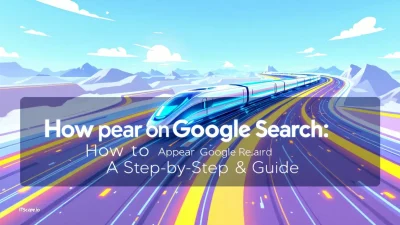In the ever-evolving world of digital marketing, tracing the history of search engine optimization is akin to discovering the secret sauce behind online visibility. Whether you’re a seasoned tech guru or a curious newbie, understanding the origins of SEO is pivotal to mastering the art of web presence. From the pixelated dawn of the 1990s to today’s sophisticated algorithms, SEO has undergone transformative changes that shape how information is accessed online.
Join us on this captivating journey through time, as we unravel the milestones and breakthroughs that define the SEO landscape. You’ll uncover fascinating insights into the evolution of search engines, pivotal algorithm updates, and strategies that have stood the test of time. Let’s dive into the past to better understand the tools of today!
Table of Contents
- The Birth of Search Engines: A Prelude to SEO
- The Evolution of SEO: From Keywords to Algorithms
- Major Milestones in SEO History
- Impact of Algorithm Updates on SEO Strategies
- Modern SEO: A Blend of Art and Science
- FAQs
- Conclusion: Learning from the Past to Innovate the Future
The Birth of Search Engines: A Prelude to SEO
Before the concept of search engine optimization emerged, the world of the internet looked vastly different. It’s fascinating to imagine a time when digital landscapes were uncharted and searching involved directories rather than the sophisticated algorithms we’re accustomed to today. Let’s embark on a journey through the history of search engines.
The 1990s heralded the emergence of the SEO platform we know today. As the internet gained traction, search engines like Archie, created by Alan Emtage, marked the beginnings of online indexing, paving the way for future innovations. As these search engines rose to prominence, so did the need for SEO strategies.
Early Search Engine Developments
When did SEO start? It’s a question many ask. The answer lies in understanding these technological breakthroughs. Around 1994, Yahoo! became a household name by offering a directory of web resources, soon followed by giants like AltaVista and WebCrawler.
With the birth of these engines, the history of search engine optimization began taking shape, setting the foundation for modern practices.
Turning Points in SEO History
1996: Search engines like Google capitalized on the need for an efficient querying system, leveraging PageRank technology that prioritized quality links. This was a pivotal shift away from simple keyword matching.
1998: The arrival of tools to manage rising search complexity indicated the critical role of search visibility, marking SEO as indispensable in the digital arena. For an in-depth exploration of SEO’s evolution, check out our SEO Tutorial.
Want More? Dive deeper into the origins and significance of these developments through this Forbes article.
The Evolution of SEO: From Keywords to Algorithms
The history of search engine optimization is a fascinating journey through time that has completely transformed how we interact with the web. From the early days when keywords ruled the roost, SEO has morphed into a sophisticated, algorithm-driven craft. But how did we get here? Let’s dive into this transformative evolution.
The Early Days: When Did SEO Start?
SEO, as we know it, began its journey in the mid-1990s. Webmasters at the time realized that by optimizing their content, they could rank higher on search engines like Yahoo and AltaVista. The focus was largely on keyword stuffing and meta-tagging. Jump over to the SEO Tutorial: The Ultimate Guide to Master Search Rankings for insights on early SEO challenges and strategies.
- Keyword Dominance: During this period, stuffing keywords into web pages seemed an effective tactic to gain visibility.
- Meta Data Usage: Meta-tags were heavily relied on for search engine visibility, often manipulated to attract traffic.
The Emergence of the SEO Platform
As search engines like Google entered the scene, the need for a more robust SEO platform became apparent. Companies started to develop tools and software aimed at understanding the PageRank algorithm and refining optimization techniques. These developments spurred the growth of an entirely new industry dedicated to optimizing websites for search success.
“SEO entered its golden age with Google’s rise, emphasizing quality content and user experience.”
The Algorithm Era: Modern SEO Approach
Today, the evolution of SEO means focusing on complex algorithms that prioritize user intent and experience over mere keyword usage. Techniques now include:
- Quality Content Creation: Algorithms favor unique, well-researched content.
- User Experience Optimization: Modern SEO demands responsive design, fast loading speeds, and accessible content.
- Link Building Strategy: A focus on acquiring authoritative backlinks has become crucial.
Whether you’re exploring the roots or current strategies, understanding the evolution of SEO helps grasp its impact on digital marketing.
To learn more about SEO’s early days, visit Search Engine Journal or check the insights from Forbes.
Major Milestones in SEO History
The history of search engine optimization is rich with innovation and pivotal moments. But when exactly did SEO start its journey? Let’s explore the key milestones that have shaped the SEO landscape as we know it today.
1. The Birth of SEO – 1990s
The emergence of the SEO platform dates back to the mid-1990s. As web directories evolved into search engines, webmasters began to refine content visibility—a precursor to modern SEO tactics.
2. Google Enters the Scene – 1998
The launch of Google in 1998 marked a seismic shift in the history of search engine optimization. With algorithm updates like Panda and Penguin, Google set new standards for quality and relevance in search results.
| Milestone | Impact |
|---|---|
| Launch of Google | Enhanced focus on relevance and user experience |
| Panda Update | Pushed for higher content quality |
| Penguin Update | Targeted spammy link practices |
3. Mobile and the Responsive Era – 2007
The introduction of smartphones brought a new dimension to SEO. Mobile-friendliness became crucial, as Google began favoring responsive web design, reflecting the user shift towards mobile browsing.
- Mobilegeddon – 2015: In a major crackdown, Google announced penalties for non-mobile-optimized sites, reinforcing the mobile-first index.
4. Voice Search and AI – Present
Today, voice search and AI-driven queries are at the forefront of SEO. This innovation signifies the continuous shift towards natural language processing and user intent, making SEO more dynamic and intuitive. For more on mastering these shifts, check out our SEO Tutorial: The Ultimate Guide to Master Search Rankings.
This rollercoaster journey from the days of basic directory listings to today’s sophisticated algorithms shows just how far the history of search engine optimization has come. For more insights, explore this insightful article on SEO’s future role.
Impact of Algorithm Updates on SEO Strategies
In the history of search engine optimization, algorithm updates have played a pivotal role in shaping SEO strategies. These updates, primarily influenced by major search engines, have dictated how websites compete for top positions. But how exactly do they impact the SEO landscape?
The big players like Google and Bing frequently tweak their algorithms to enhance user experience, focusing on relevance and quality. When an update hits, SEO experts must adapt quickly or risk losing visibility. That’s why understanding these changes is crucial for staying ahead.
Emergence and Evolution
From the early days of SEO, strategies have evolved parallel to algorithm changes. When did SEO start? It traces back to the mid-1990s when search engines like AltaVista emerged. With each algorithm update, such as Google’s Panda and Penguin, the focus shifted from keyword stuffing to quality links and content relevancy. These updates punished sites using outdated tactics, pushing the emergence of the SEO platform as we know it today—one that thrives on white-hat tactics.
Strategic Adaptations
- Content Relevancy: Quality content now reigns supreme. Crafting content that satisfies user intent has become key.
- Link Building: Earning authentic backlinks is crucial. Build partnerships and guest post on reputable sites.
- Technical Optimization: Ensure solid site architecture and loading speeds to please search engine bots.
Adapting to algorithm updates is essential to maintain visibility in the evolving history of search engine optimization.
Understanding the impact of algorithm updates lets businesses fine-tune their SEO efforts, keeping them in line with search engine preferences. For those interested, exploring case studies on the SEO Tutorial can deepen your insights.
Modern SEO: A Blend of Art and Science
In the ever-evolving history of search engine optimization, modern SEO represents a fusion between creative ingenuity and technical prowess. But how did this intricate dance begin? Tracing the emergence of the SEO platform reveals innovations that have revolutionized the digital landscape.
Modern SEO is both an art and a science. It requires creativity in crafting compelling content that captivates audiences and technical skill in optimizing that content for search engines. This synchronized effort ensures that a website not only attracts but also engages users effectively.
The Art of SEO
The artistic aspect of SEO is about storytelling and engagement. Creating content that resonates emotionally and provides value keeps readers returning. Think of it as painting a picture with words—it’s about colors, appeal, and memorable messages. Regularly updating and refreshing content breathes new life into old material, pushing it higher in search engine rankings. Want to learn more? Check out our detailed guide on mastering search rankings.
The Science of SEO
Now, the scientific side of SEO is another ball game. It’s about numbers, algorithms, and analytics. This involves ensuring proper keyword usage, like the history of search engine optimization, and implementing on-page and off-page strategies that align with evolving search engine guidelines. Understanding when SEO started helps in appreciating these complex changes and progressions. Comprehensive data analysis and an examination of site metrics strengthen this aspect.
Key benefit of blending art and science in SEO: Enhanced visibility and higher engagement.
For an abbreviated yet insightful look at SEO’s roots, explore this external reference.
FAQs
When did SEO start?
The history of search engine optimization began in the mid-1990s when search engines first appeared. Webmasters and content providers started to optimize sites for search engines like Yahoo and AltaVista to improve visibility.
What is the emergence of the SEO platform?
The emergence of the SEO platform marks a pivotal moment in the history of search engine optimization. These platforms began to provide the analytics and tools necessary to streamline and enhance SEO practices.
Why is SEO important for online visibility?
SEO is crucial for increasing web traffic and improving site credibility. By optimizing your website according to SEO best practices, you ensure that your content reaches a broader audience. Check out our SEO Tutorial for deeper insights.
How has SEO evolved over the years?
The history of SEO shows a shift from simple keyword placement to today’s complex practices like voice search optimization and AI. It reflects changing algorithms and user behaviors over the years.
What are the key components of modern SEO?
Modern SEO includes keyword research, content optimization, technical SEO, and backlinks. Staying updated with the latest SEO techniques is essential for maintaining visibility and ranking.
Conclusion: Learning from the Past to Innovate the Future
The history of search engine optimization is more than a timeline; it’s a learning path that shapes tomorrow’s strategies. As we reflect on when did SEO start and the emergence of the SEO platform, we gain insights to fuel innovation. With these insights, we forge strategies that adapt to future changes. For those keen to delve deeper, our SEO Tutorial offers comprehensive guidance. The journey of SEO remains dynamic, continually informing why understanding its past is pivotal for crafting its future.



